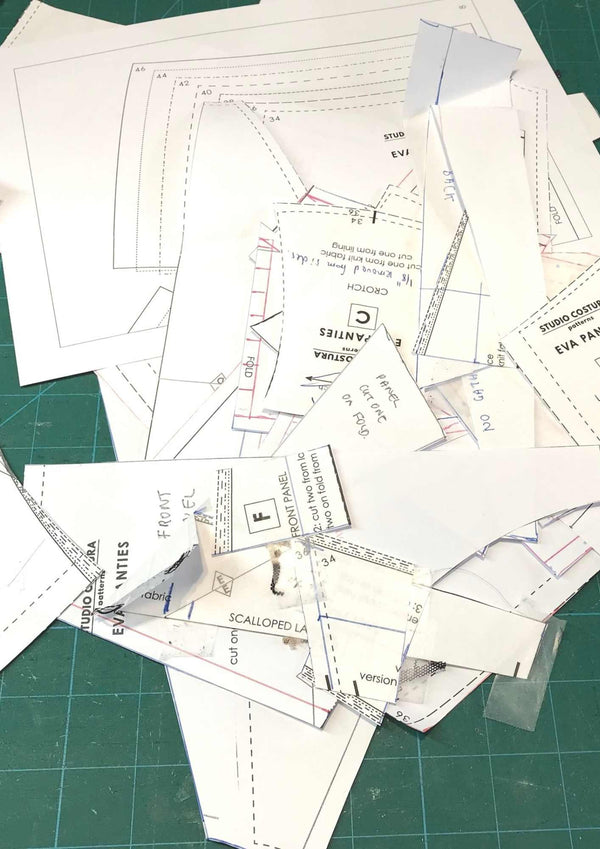HOW TO DO PANTY DRAFTING: A STEP-BY-STEP GUIDE

Creating A Well-Fitting Panty Requires Precise Drafting To Ensure Comfort, Style, And Functionality. Panty Drafting Involves Creating A Pattern Tailored To Different Body Shapes And Sizes, Forming The Foundation Of A Great Pair Of Underwear. Whether You're A Budding Designer Or A DIY Enthusiast, Learning How To Draft Panties Is A Valuable Skill. Here’s A Comprehensive Guide To Help You Through The Process.
- Understanding Panty Anatomy
Before Drafting, It's Essential To Understand The Basic Components Of A Panty:
- Front Panel: The Part Covering The Front Of The Body.
- Back Panel: Covers The Rear And Often Provides The Most Fabric.
- Crotch Gusset: A Piece Of Fabric In The Crotch Area That Adds Comfort And Hygiene.
- Waistband: The Top Edge Of The Panty, Usually Elasticized For A Snug Fit.
- Leg Openings: The Openings For The Legs, Typically Finished With Elastic Or Binding For Comfort.
- Gathering Tools And Materials
To Begin Drafting Your Panty Pattern, You'll Need:
- Pattern Paper
- Measuring Tape
- Rulers (Straight And Curved)
- French Curve
- Pencil And Eraser
- Scissors
- Basic Measurements (Waist, Hip, And Crotch Depth)
- Taking Accurate Measurements
The Key To A Well-Fitting Panty Is Accurate Measurements. Here's What You'll Need:
- Waist Measurement: Measure Around The Natural Waistline, Where The Waistband Of The Panty Will Sit.
- Hip Measurement: Measure Around The Fullest Part Of The Hips.
- Crotch Depth: Sit On A Flat Surface And Measure Vertically From The Waistline To The Seat Of The Chair.
- Side Seam Length: Measure From The Waist To Where You Want The Leg Opening To End On The Side.
- Drafting The Basic Panty Block
The Panty Block Is The Foundation For Creating Any Panty Style. Here’s How To Draft It:
Step 1: Draft The Basic Grid
- Draw A Vertical Line In The Center Of Your Paper; This Will Be The Center Front And Back Line.
- Draw A Horizontal Line At The Top To Represent The Waistline.
- From The Waistline, Mark The Crotch Depth Vertically And Draw A Horizontal Line (Crotch Line).
- From The Crotch Line, Extend Down To The Desired Length Of The Panty (To Cover The Buttocks Adequately).
Step 2: Draft The Front Panel
- Waistline: Divide The Waist Measurement By 4 And Mark This Distance On The Waistline.
- Hip Line: Divide The Hip Measurement By 4 And Mark This On The Crotch Line.
- Curve The Side Seam: Use The French Curve To Create A Gentle Curve Connecting The Waist And Hip Points.
- Crotch Extension: At The Crotch Line, Draw A Horizontal Extension (Around 5-7 Cm) To Form The Crotch Point.
- Leg Opening: Shape The Leg Opening By Drawing A Curved Line From The Crotch Point To The Side Seam.
Step 3: Draft The Back Panel
- Waistline: On The Opposite Side Of The Centerline, Mark The Waist Measurement Divided By 4.
- Hip Line: Mark The Hip Measurement Divided By 4 On The Crotch Line.
- Curve The Side Seam: Connect The Waist And Hip Points With A Smooth Curve.
- Crotch Extension: Extend The Crotch Horizontally (Around 7-9 Cm) To Form The Back Crotch Point.
- Leg Opening: Draw A Curved Line From The Back Crotch Point To The Side Seam For The Leg Opening. The Back Leg Curve Is Usually Higher Than The Front For Better Coverage.
Step 4: Draft The Gusset
- Draw A Separate Piece For The Crotch Gusset. The Gusset Width Is Usually Around 5-7 Cm, And The Length Depends On The Front And Back Crotch Extensions.
- The Gusset Piece Should Have Curved Edges That Align With The Front And Back Crotch Seams For A Smooth Fit.
- Adding Seam Allowances And Adjustments
- Add Seam Allowances (Typically 0.5-1 Cm) Around All Pattern Pieces.
- Mark The Waistband Fold Line And Leg Opening Edges, Noting Where The Elastic Will Be Sewn.
- Customizing The Panty Style
Now That You Have A Basic Block, You Can Modify It To Create Different Styles:
- Bikini: Lower The Waistline And Adjust The Leg Openings For A Higher Cut.
- Boyshorts: Extend The Leg Openings Downward For A More Square-Shaped Appearance.
- High-Waisted: Raise The Waistline For More Coverage.
- Thong: Narrow The Back Panel And Adjust The Leg Opening Curves.
- Testing The Pattern
- Sew A Test Panty Using A Stretch Fabric Similar To Your Final Fabric Choice.
- Fit The Test Panty To Assess The Fit, Comfort, And Overall Design.
- Make Any Necessary Adjustments To The Pattern For A Better Fit.
- Finalizing The Pattern
- Once You're Satisfied With The Fit, Transfer The Final Pattern To Sturdier Material Like Cardstock.
- Label Each Piece (Front, Back, Gusset) And Indicate Important Information Like Grainlines And Fold Lines.
Tips For Successful Panty Drafting
- Use Stretch Fabrics: Panties Are Usually Made From Stretch Fabrics Like Jersey, Spandex, Or Cotton Blends. Always Consider Fabric Stretch When Drafting.
- Elastic Consideration: Remember That Elastic Will Pull The Fabric Slightly, So Account For This When Drafting The Leg Openings And Waistline.
- Experiment With Styles: Once You Master The Basic Panty Block, Experiment With Various Styles, Cuts, And Fabric Choices.



